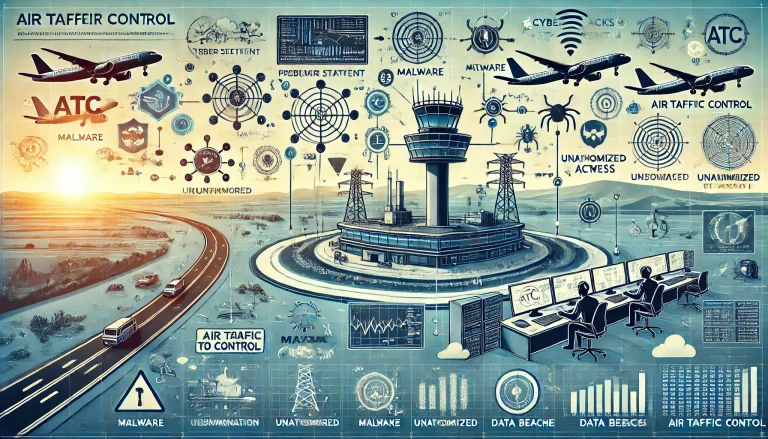Problem Statement
The integration of Unmanned Aerial Vehicles (UAVs), commonly known as drones, into commercial airspace represents a transformative shift in the aviation industry. UAVs offer immense potential across various sectors, including logistics, agriculture, surveillance, and emergency response. However, incorporating these vehicles into airspace traditionally dominated by manned aircraft poses a range of significant challenges. Ensuring the safety of both manned and unmanned aircraft is paramount, as even minor incidents involving UAVs could have catastrophic consequences in crowded airspace.
Managing air traffic control (ATC) in this new environment is another critical challenge. Existing ATC systems are designed primarily for manned aircraft, which operate at higher altitudes and have more predictable flight paths. UAVs, on the other hand, often fly at lower altitudes, are smaller, and can have more varied and dynamic flight patterns. Integrating these two types of aircraft requires the development of new technologies and systems to monitor and manage airspace effectively, ensuring that UAVs can operate safely alongside traditional aircraft without causing disruptions or accidents.
Privacy and security concerns also play a crucial role in the debate over UAV integration. UAVs equipped with cameras and sensors can gather extensive data, raising concerns about surveillance, data protection, and the potential misuse of collected information. Additionally, the possibility of UAVs being used for malicious purposes, such as smuggling, espionage, or even terrorist attacks, necessitates robust security measures and regulations to mitigate these risks.
Addressing these challenges requires a coordinated effort between the aviation industry, regulatory bodies, and technology developers. New regulations must be established to govern UAV operations, covering aspects such as flight paths, air traffic management, privacy protections, and security protocols. At the same time, technological innovations must be pursued to enhance UAV capabilities, improve safety, and ensure seamless integration with existing airspace management systems.
Pain Points
- Safety of Manned and Unmanned Aircraft: The risk of collisions and accidents between UAVs and traditional aircraft.
- Air Traffic Control Challenges: The need to develop new systems for managing mixed airspace with both manned and unmanned vehicles.
- Privacy Concerns: Potential for UAVs to infringe on privacy through unauthorized data collection and surveillance.
- Security Risks: The threat of UAVs being used for illegal or malicious activities, including smuggling and terrorism.
- Regulatory Gaps: Lack of comprehensive regulations governing the operation of UAVs in commercial airspace.
- Technological Limitations: Current UAV technologies may not be fully equipped to operate safely in congested airspace.
- Public Trust: Building confidence among the public and stakeholders in the safe integration of UAVs.
- Infrastructure Adaptation: Modifying existing aviation infrastructure to accommodate UAV operations.
- Environmental Impact: Addressing concerns related to noise, emissions, and wildlife disturbance from increased UAV activity.
- Coordination Between Stakeholders: Ensuring effective collaboration between government agencies, industry players, and the public.

Future Vision
Our platform envisions a future where UAVs are seamlessly integrated into commercial airspace, operating safely alongside manned aircraft while providing a wide range of benefits across industries. To achieve this, the platform will support the development of advanced air traffic management systems that can monitor and control both manned and unmanned aircraft in real-time. These systems will utilize AI and machine learning to predict and manage flight paths, ensuring that UAVs can operate without interfering with traditional aviation.
Safety will be a top priority, with the platform advocating for the implementation of collision avoidance technologies, redundant communication systems, and fail-safe mechanisms to prevent accidents. Privacy and security will also be addressed through the development of robust encryption, data protection protocols, and regulations that define acceptable UAV use and prohibit unauthorized surveillance or data collection.
Regulatory frameworks will be established in collaboration with international aviation bodies, ensuring consistent standards for UAV operation across different regions. These regulations will cover aspects such as flight permissions, altitude restrictions, no-fly zones, and emergency response protocols. The platform will also work to adapt existing aviation infrastructure, such as airports and ATC systems, to accommodate the unique requirements of UAV operations.
To build public trust, the platform will engage in transparent communication with stakeholders, including the general public, industry players, and government agencies. By addressing concerns related to safety, privacy, and security, the platform will help foster a positive perception of UAV integration and encourage widespread adoption of the technology.
Through these initiatives, our platform aims to create a safe, efficient, and secure environment for UAVs in commercial airspace, unlocking their full potential while safeguarding the interests of all stakeholders.
Use Cases
- Advanced Air Traffic Management: Developing systems that monitor and manage both manned and unmanned aircraft in real-time.
- Collision Avoidance Technologies: Implementing AI-driven systems to prevent collisions between UAVs and other aircraft.
- Privacy and Data Protection Protocols: Establishing guidelines for the responsible use of UAVs and protecting against unauthorized surveillance.
- Security Measures for UAVs: Developing technologies and regulations to prevent the use of UAVs for illegal activities.
- Regulatory Frameworks: Creating consistent regulations for UAV operation across different regions and airspaces.
- Infrastructure Adaptation: Modifying existing aviation infrastructure to support UAV operations.
- Public Engagement and Communication: Building public trust through transparent communication and addressing safety concerns.
- Environmental Impact Mitigation: Implementing measures to minimize the environmental impact of UAVs, including noise and emissions control.
- Emergency Response Protocols: Developing protocols for the safe management of UAVs in emergency situations.
- Coordination Between Stakeholders: Facilitating collaboration between government agencies, industry players, and the public to ensure successful UAV integration.
Target Users and Stakeholders
- User: Aviation Regulators, Air Traffic Controllers, UAV Operators, and Aviation Safety Experts
- Age Group: 30-60 years
- Gender: M/F
- Usage Pattern: Regular usage for managing airspace safety, developing regulations, and ensuring the secure integration of UAVs
- Benefit: Enhanced airspace management, improved safety, and successful integration of UAVs into commercial airspace
- Stakeholders:
- Aviation Authorities: Agencies responsible for regulating and overseeing air traffic and safety
- UAV Manufacturers: Companies developing and producing UAVs for commercial use
- Airlines: Operators of manned aircraft that share airspace with UAVs
- Public: General population concerned with the safety, privacy, and environmental impact of UAVs
- Technology Developers: Companies creating systems for air traffic management, collision avoidance, and data protection
Key Competition
- DJI: Leading manufacturer of commercial UAVs with a focus on safety and ease of use.
- Parrot: Develops UAVs for commercial applications, including air traffic management systems.
- Boeing: Invests in UAV technology and air traffic management solutions to support the safe integration of UAVs.
- Airbus: Focuses on developing UAV technologies and systems for safe operation in commercial airspace.
- Lockheed Martin: Provides UAV systems and air traffic management solutions for both commercial and military applications.
Products/Services
- DJI UAVs: Commercial drones with advanced safety features and easy-to-use controls.
- Parrot UAV Systems: UAVs designed for commercial applications, including air traffic management.
- Boeing Air Traffic Solutions: Systems designed to manage the integration of UAVs into commercial airspace.
- Airbus UAV Technologies: UAV systems focused on safety and efficient operation in mixed airspace.
- Lockheed Martin UAV Solutions: Comprehensive UAV systems and air traffic management technologies.
Active Startups
- Skydio: Develops AI-driven UAVs with advanced collision avoidance capabilities.
- PrecisionHawk: Provides UAV solutions for airspace management and data collection.
- Dedrone: Focuses on security solutions to detect and prevent unauthorized UAV activities.
- AirMap: Develops airspace management platforms for safe UAV integration into commercial airspace.
- Altitude Angel: Provides air traffic management solutions specifically for UAVs.
- Iris Automation: Creates detect-and-avoid systems for UAVs to enhance airspace safety.
- Zipline: Uses UAVs for medical supply delivery, focusing on safety and reliability in mixed airspace.
- DroneDeploy: Offers UAV-based data solutions with a focus on safety and compliance.
- Kittyhawk: Provides enterprise-level UAV management and compliance solutions.
- Wingcopter: Develops UAVs for logistics and delivery, with a focus on airspace safety and efficiency.
Ongoing Work in Related Areas
- Air Traffic Management Research: Developing new systems to manage the integration of UAVs into commercial airspace.
- Collision Avoidance Technology: Advancing AI-driven systems to prevent accidents between UAVs and manned aircraft.
- UAV Security Protocols: Creating standards and technologies to prevent the misuse of UAVs for illegal activities.
- Environmental Impact Studies: Researching the effects of increased UAV activity on noise levels, emissions, and wildlife.
- Public Perception and Trust: Conducting studies to understand public concerns and improve the perception of UAV integration.
Recent Investment
- Skydio: $100M in Series C funding led by Andreessen Horowitz, July 2020.
- PrecisionHawk: $32M in Series E funding led by Millennium Technology Value Partners, February 2020.
- Dedrone: $12M in Series B funding led by Menlo Ventures, October 2018.
- AirMap: $26M in Series C funding led by Microsoft Ventures, February 2018.
- Altitude Angel: $5.3M in Series A funding led by Seraphim Capital, September 2018.
Market Maturity
The market for UAV integration into commercial airspace is rapidly maturing, driven by advancements in air traffic management systems, collision avoidance technologies, and security protocols. Companies like DJI, Parrot, and Boeing are leading the way with advanced UAV technologies and systems designed to ensure safe and efficient operation in mixed airspace. At the same time, startups like Skydio, PrecisionHawk, and Dedrone are innovating in areas such as AI-driven UAVs, airspace management, and UAV security. Significant investments in these areas are transforming the aviation industry, enabling the safe integration of UAVs into commercial airspace. As the market continues to evolve, we expect to see more sophisticated and secure solutions that address the unique challenges of UAV integration.
Summary
The integration of Unmanned Aerial Vehicles (UAVs), or drones, into commercial airspace presents significant challenges. These include ensuring the safety of manned and unmanned aircraft, managing air traffic control, and addressing privacy and security concerns. The aviation industry must develop new regulations and technologies to safely and efficiently incorporate UAVs into existing airspace. Our proposed platform leverages advanced air traffic management, collision avoidance technologies, privacy and data protection protocols, security measures, and regulatory frameworks to address these challenges. Key pain points include safety risks, air traffic control challenges, privacy concerns, security risks, regulatory gaps, technological limitations, public trust, infrastructure adaptation, environmental impact, and stakeholder coordination.
Target users include aviation regulators, air traffic controllers, UAV operators, and aviation safety experts, with stakeholders encompassing aviation authorities, UAV manufacturers, airlines, the public, and technology developers. Key competitors like DJI, Parrot, Boeing, Airbus, and Lockheed Martin offer various UAV systems and air traffic management solutions, while startups such as Skydio, PrecisionHawk, and Dedrone are driving innovation in this space. Recent investments highlight significant interest and growth potential in platforms addressing the challenges of UAV integration.
By addressing these challenges and leveraging advanced technologies, our platform aims to create a safe, efficient, and secure environment for UAVs in commercial airspace, unlocking their full potential while safeguarding the interests of all stakeholders.



